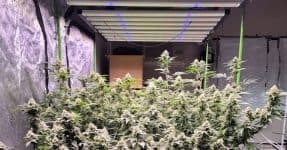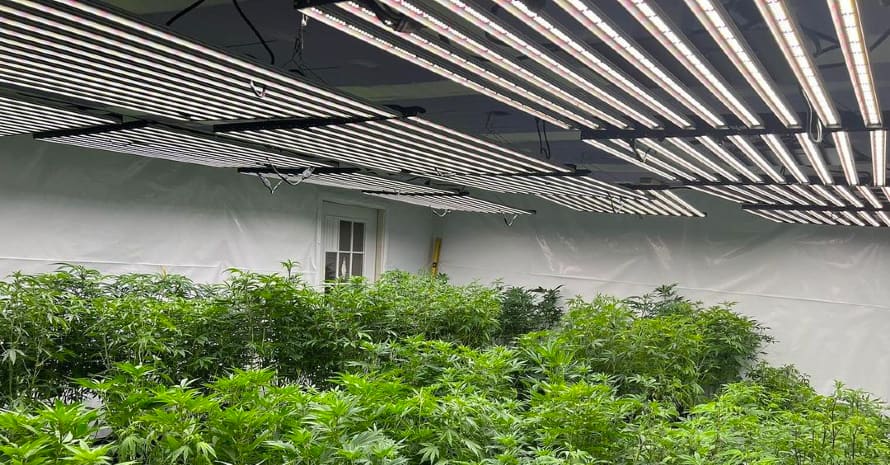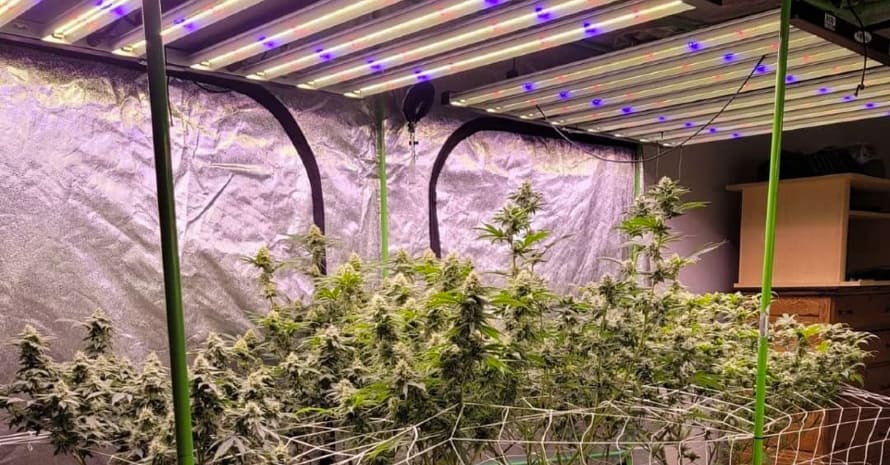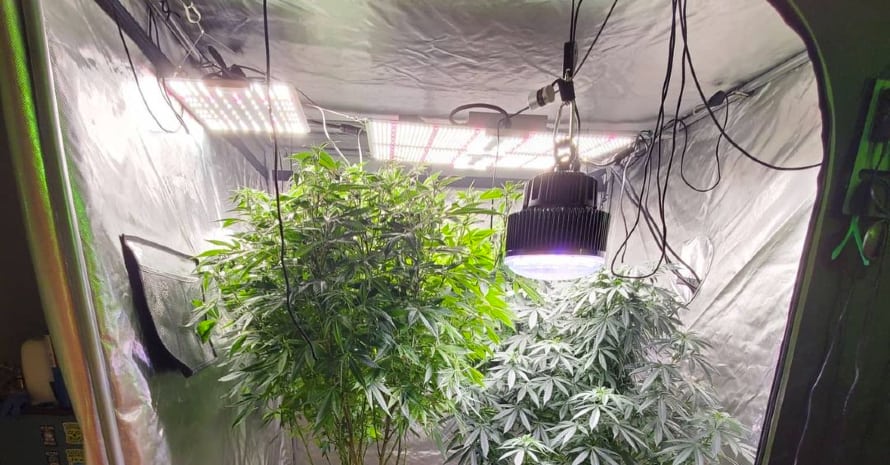
How to Lower Humidity in Grow Tent?
Humidity is the moisture in the air. If you have a lot of moisture in the air, it’s going to be hard for your plants to breathe. Plants will be unable to get the oxygen they need from the air. Providing the correct level of humidity in your grow room is just as important as providing the correct temperature. The two main problems that may arise from an incorrect level of humidity are:
- Powdery mildew
- Fungal diseases
It’s important to have the humidity level in your grow tent as low as possible to allow for better airflow. You will have less mold, mildew, and fungus in your grow tent.
What is the Humidity in a Grow Tent?
Contents
Humidity is the amount of water vapor in the air. In general, the higher the humidity, the higher the risk of mold and mildew. The best way to control the humidity in a grow tent is a dehumidifier or a venting fan. If you are growing in a tent, you need to set it up in a place where it is constantly ventilated. If you are growing in a garden, make sure you have a place where you can easily set up a fan.
What is a Grow Tent Used For?
A grow tent is a tent designed for growing plants indoors. It is often used in the context of growing marijuana but can be used for growing a variety of plants. Grow tents are typically made of metal. Some of them can also be made of plastic or canvas.
In many ways, a grow tent is a tent for growing plants indoors. However, grow tents also have a few specific features that make them excellent for growing cannabis. Grow tents are designed to fit a number of plants in a relatively small space, so you can grow a large number of plants in a relatively small room. A grow tent is also designed to provide excellent light-capturing potential. Most grow tents come with a reflective lining inside the tent that directs light back to the plants.
A grow tent is also designed to be easy to set up, so it is easy to move plants in and out of the grow tent with minimal effort. Grow tents are also designed to be easy to maintain. They are typically easy to set up and come with filters that can be set up to provide an excellent growing environment while filtering out odors. Grow tents also come with a metal frame that can be installed in a matter of minutes.
How are Grow Tents Different from Other Kinds of Tents?
Grow tents are not like other tents. Most tents are designed to be set up in a matter of minutes and to be easy to set up. Grow tents are designed to be easy to set up and move but are also designed to be easy to maintain. Most tents do not come with filters and reflective linings. Many tents also do not have a reflective lining, as this is not typically necessary. Grow tents are designed to be used in a tight space, so the reflective lining makes it easier for the plants to get enough light.
Ideal Temperature and Humidity for a Grow Tent
The temperature can vary depending on the plant species. For example, the optimal temperature for growing cannabis is between 70 to 80 degrees Fahrenheit. You should try to keep your grow room below 90 degrees. This is because too much heat can cause your plant to grow slowly and the plant’s leaves will become pale and the stems will be weak.
A good starting point for the temperature is to keep it at 70 degrees during the day and lower it to 60 degrees at night. If you are growing marijuana in a hot area, you may want to adjust the temperature accordingly. A good rule of thumb is to keep your tent around the same temperature that is comfortable for you.
Ideally, the ideal humidity for a growing tent is around 60-70%. This will allow the plants to grow in a healthy, moist environment and will also help to prevent pests and diseases. The ideal humidity for growing marijuana is between 40 to 60%. If you are using a hydroponics system, you will probably need to add humidity to your grow room. The easiest and cheapest way to increase humidity is to use a cool-mist humidifier. You can also open windows or doors to increase airflow. You should also monitor the plants to see if they are drooping or wilting, which would indicate that you need to increase the humidity.
Ways to Adjust Humidity in Your Grow Tent
There are a few ways to control humidity in a grow tent. One way is to use a humidity controller to ensure that the tent has a consistent humidity level. Another way is to place a window in the tent to allow enough air to circulate and create a more comfortable environment. Finally, you can use a humidifier to increase the humidity in the tent.
Use a Venting Fan
If you are growing in a tent, make sure you invest in a good venting fan. If you are growing in a garden, make sure you have a place where you can easily set up a fan. What is a venting fan? A venting fan is a regular fan that is designed to remove hot air from your grow tent. If you are growing in a tent, make sure you buy a venting fan that has a removable filter. The best venting fans are the ones that are designed to prevent dust from entering your environment. Make sure the fan you buy is powerful enough to remove the hot air from your grow tent.
Use a Dehumidifier
If you are growing indoors, you need to control the humidity. The best way to do this is by using a dehumidifier. What is a dehumidifier? A dehumidifier is a device used to remove water vapor from the air. Dehumidifiers should be used at all times if you are growing in a small space. Dehumidifiers are best used if you are growing in a grow tent or a small closet. The best models of dehumidifiers will have a drainage system. It is important that you select a model that can be easily drained.
Use an Air Circulation
Air circulation is the easiest and cheapest way to lower the humidity in your grow room. The principle is very simple. All you have to do is to create “wind” in your grow room. The wind will take with him the water vapor from the plant and will get rid of it from the grow tent. This way, the plant will not sweat anymore.
You can create air circulation easily by using either a fan or a grow room ventilation system. If you choose to use a fan, the easiest way to do it is to place one fan inside your grow tent and to use duct tape to “seal” the door. This will make sure that the air is blown only inside the grow room. If you decide to use a grow room ventilation system, you can either place it inside your grow tent or outside of it. The only difference is that you will not have to worry about using duct tape.
Use an Air Conditioner
Air conditioners (AC) are expensive and not suitable for everyone. They can also be very loud, and the power consumption is not too good. But air conditioners can help you get rid of the humidity in your grow room.
The principle is very simple. Air conditioners can lower the humidity of the air. If you want to lower the humidity of your room, you just have to turn on your AC before your plants start sweating. This way AC will lower the temperature of your grow room by a few degrees. This will keep the plants from sweating when the temperature is lower.
How to Lower Humidity in Grow Tent?
It is recommended to use a dehumidifier in the grow room to reduce the humidity level. Humidity can be reduced by opening all windows, doors, and vents in the dry season. In the wet season, it is advisable to spray water in the air to reduce the humidity.
1. How to lower humidity in grow tent during the vegetative stage?
It is recommended to use a humidifier to raise the humidity in the grow room during the vegetative stage. This will help the plant grow healthy and strong.
2. How to lower humidity in grow tent during the flowering stage?
It is advisable to use a dehumidifier to reduce humidity in the grow room during the flowering stage. This is because, during this stage, the plant requires more air circulation and a dry environment to facilitate better flower production.
3. How to lower humidity in grow tent during the cloning?
It is recommended to keep the temperature at around 70°F. The humidity can be reduced by opening doors and windows and by spraying water in the air.
How to Remove Humidity from a Room without a Dehumidifier?
When it comes to removing humidity from a grow tent, there are a few different options that growers can employ. One of the most popular options to remove humidity from a grow tent is to use a dehumidifier. However, if you don’t have a dehumidifier and don’t want to buy one, there are still some other options to remove humidity from a grow tent.
Remove Fresh Air
One of the easiest ways to remove humidity from a grow tent is to remove fresh air from the grow tent. This is a very simple process that works with a fan. Basically, a fan will circulate the air in the grow tent, and this will allow the air to be exhausted from the grow tent. You can either mount the fan to the roof of the grow tent or hang it from the top of the grow tent, and then use ducting to move the air into a duct connected to the outside of the grow tent. Another option that many growers use is a carbon scrubber. A carbon scrubber works by scrubbing the air of any particles. This will remove any particles in the air that might be causing a problem in the grow tent. Particle scrubbers are very popular with growers because they are very effective, and the cost of a particle scrubber is very reasonable.
How to Maximize Ventilation in a Grow Tent?
One of the most important things that you can do to maximize ventilation in a grow tent is to make sure that your fan is working as efficiently as possible. If your fan is not working properly, it will not be able to remove enough air from the grow tent, and this will result in poor air circulation and poor ventilation.
What you want to do is make sure that you have your fan set up correctly. If your fan is too close to the wall, it will not be able to pull as much air from the grow tent. It is best to have the fan at least a foot away from the wall, if not further. If your fan is not back far enough, it will not be able to pull the air from all areas of the grow tent, and this will result in hotspots. Make sure that your fan is set up in a way that it is pulling the air from a good distance away from the plants. You also want to make sure that you are using a fan that is powerful enough for your grow tent.
You want a fan that is rated for the proper size of the grow tent. Furthermore, you should also make sure that your fan is running at the proper speed. If your fan is not running at the proper speed, it will not be able to pull enough air from your grow tent, and this will cause problems. There are also a few other things that you can do to maximize ventilation in a grow tent. One of the best ways to create a proper environment in your grow tent is to make sure that the temperature is at the right level. You want to make sure that you have a temperature that is at least 20 degrees above the temperature outside of the grow tent. If you do not have a temperature that is 20 degrees above outside, there is a good chance that your plants will have a hard time growing in your grow tent.
Another thing that you can do to maximize ventilation in your grow tent is to make sure that you are using a carbon scrubber. Carbon scrubbers are very popular with growers because they are very effective, and the cost of a carbon scrubber is very reasonable. Carbon scrubbers work by scrubbing the air of any particles. This will remove any particles in the air that might be causing a problem in the grow tent. If you want to maximize ventilation in your grows tent, a carbon scrubber is a great option for removing particles from the air.
What is a Grow Tent Humidity Controller?
A room humidity controller is used to control the humidity inside a room. They have a built-in sensor that detects the humidity level inside the room. This sensor will then send a signal to a fan to turn on / off.
The Difference between a room humidity controller and a grow tent humidity controller:
- The grow tent humidity controller is used to control the humidity level inside a grow tent. The room humidity controller is used to control the humidity level inside a room.
- The sensor inside the grow tent humidity controller is built-in, and the sensor inside the room humidity controller is bought separately.
- The fan inside the grow tent humidity controller is built-in, and the fan inside the room humidity controller is bought separately.
- The grow tent humidity controller has a built-in low/high-temperature sensor, the room humidity controller does not have a built-in low/high-temperature sensor.
- The grow tent humidity controller is powered by a built-in fan, and the room humidity controller is powered by a bought-separately fan.
- The grow tent humidity controller can control the humidity level inside 1 grow tent, and the room humidity controller can control the humidity level inside 1 room.
- The grow tent humidity controller is built to be used in a grow tent, and the room humidity controller is built to be used in a room.
- The grow tent humidity controller is a digital controller, and the room humidity controller is not a digital controller.
- The grow tent humidity controller has a built-in timer, the room humidity controller does not have a built-in timer.
- The grow tent humidity controller has a built-in display, but the room humidity controller does not have a built-in display.
- The grow tent humidity controller has a built-in temperature sensor, the room humidity controller does not have a built-in temperature sensor.
- The grow tent humidity controller uses a built-in heater, and the room humidity controller does not use a built-in heater.
- The grow tent humidity controller uses a built-in ventilation system, and the room humidity controller does not use a built-in ventilation system.
Grow Tent Humidity Level
Some of the things that affect grow tent humidity levels are
- Plant strain;
- Plant size.
There are several methods that can be used to measure a grow tent’s humidity level. But the best and most accurate way to measure a grow tent humidity level is using a good quality calibrated hygrometer. The most popular ones are:
- Buckets Electromagnetic Thermometers: this type of hygrometer is usually used in bathrooms and saunas. They work by detecting the change in temperature in the air. These types of hygrometers are not used by professional growers as they are not very accurate in detecting humidity levels.
- Electronic Hygrometers: this type of hygrometer is used by most growers. As it is best for growing most plants indoors. Most of the growers use the electronic hygrometer in their grow tent.
Hygrometers are the most accurate and are used by most growers.
Conclusion
Unfortunately, most people don’t realize how large of an effect humidity has on their plants. They will have great-looking plants at first, but then when the humidity gets too high, they start to get sick. If you experience this, you need to lower the humidity levels in your grow tent.







